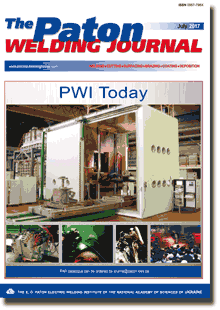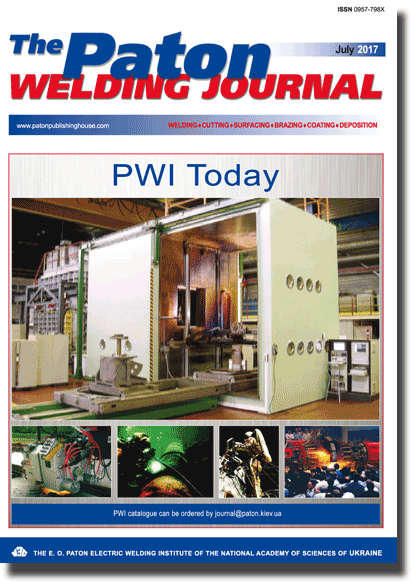| 2017 №07 (04) |
DOI of Article 10.15407/tpwj2017.07.05 |
2017 №07 (06) |

The Paton Welding Journal, 2017, #7, 23-27 pages
Hybrid plasma-arc welding of thin-walled panels from aluminium alloy
V.N. Korzhik
E.O. Paton Electric Welding Institute, NASU 11 Kazimir Malevich Str., 03680, Kiev, Ukraine. E-mail: office@paton.kiev.ua
Abstract
The urgency of this work is associated with the need to develop accessible highly efficient technology of welding thin-walled ship panels from Al–Mg system alloys, which will allow minimizing the effect of deterioration of strength characteristics of the produced joints, characteristic for traditional arc welding methods, as well as reducing weld width and welding heat input without any essential increase of welding equipment cost. Research performed by the author was the base to propose the technology of hybrid plasma-MIG welding with axial feed of wire through hollow circular electrode, allowing production of joints of thin-walled (5–8 mm) ship panels from aluminium alloys of Al–Mg system, with strength higher than 80 % of that of base metal and by 3–6 % higher than strength provided by consumable electrode pulsed-arc welding. Developed technology allows improvement of the efficiency of manufacturing ship panels 5–8 mm thick, compared to currently applied consumable electrode pulsed-arc welding due to improvement of welding speed by 25–40 % and elimination of the need for edge preparation. It is shown that application of hybrid plasma-arc welding, compared to traditional consumable electrode arc welding allows reducing weld width by approximately 20 % and decreasing by 10–15 % the quantity of wire used for weld formation of the same process speed. Here, welding heat input is reduced by 20–30 % that promotes an improvement of strength characteristics and reduction of the width of base metal softening zone under the impact of welding arc heat. 10 Ref., 3 Tables, 5 Figures.
Keywords: aluminium alloys, direct action plasma, consumable electrode arc, hybrid welding, welding mode, weld hardness, joint strength
Received: 06.04.17
Published: 01.09.17
References
- Zusin, V.Ya., Serenko, V.A. (2004) Welding and surfacing of aluminium and its alloys. Mariupol: Renata.
- Rabkin, D.M. (1986) Metallurgy of fusion welding of aluminium and its alloys. Kiev: Naukova Dumka.
- Essers, W.G., Jelmorini, G. (1975) Method of plasma-MIG-welding. U.S. Philips Corp. Pat. US3891824.
- Essers, W.G., Liefkens, A.C. (1972) Plasma-MIG welding developed by Philips. Machinery and Production Engineering, 12, 632–633.
- Essers, W.G., Willemes, G.A. (1984) Plasma-MIG-Schweissen von Aluminium Auftragschweissen und Zweielektrodenschweissen. DVS-Berichte, 90, 9–14.
- Dedyukh, R.I. (2014) Peculiarities of consumable electrode plasma welding (Review). Proizvodstvo, 5, 34–39.
- Yang Tao, Gao Hongming, Zhang Shenghu et al. (2013) The study on plasma-mig hybrid arc behaviour and droplet transfer for mild steel welding. on Advanced Materials, 33, 459–464.
- Grinyuk, A.A., Korzhik, V.N., Shevchenko, V.E. et al. (2016) Hybrid technologies of welding aluminium alloys based on consumable electrode arc and constricted arc. The Paton Welding J., 5/6, 98–103. https://doi.org/10.15407/tpwj2016.06.17
- http://www.dvs-aft.de/Aft/V/V2/V2.3/V2.3.5. Deutscher Verband fuer Schweissen und verwandte Verfahren e.V. Ausshuss fuer Technik. Arbeitsgruppe V 2.3.5 Plasma-MIG-Schweissen.
- ND 2-020101-040 (2013): Rules of technical supervision in construction of ships and manufacture of materials and products for ships. Vol. 2. St.-Petersburg: Russian Maritime Register of Shipping.
Suggested Citation
V.N. Korzhik (2017) Hybrid plasma-arc welding of thin-walled panels from aluminium alloy. The Paton Welding J., 07, 23-27.The cost of subscription/purchase order journals or individual articles
| Journal/Currency | Annual Set | 1 issue printed |
1 issue |
one article |
| TPWJ/USD | 384 $ | 32 $ | 26 $ | 13 $ |
| TPWJ/EUR | 348 € | 29 € | 24 € | 12 € |
| TPWJ/UAH | 7200 UAH | 600 UAH | 600 UAH | 280 UAH |
| AS/UAH | 1800 UAH | 300 UAH | 300 UAH | 150 UAH |
| AS/USD | 192 $ | 32 $ | 26 $ | 13 $ |
| AS/EUR | 180 € | 30 € | 25 € | 12 € |
| SEM/UAH | 1200 UAH | 300 UAH | 300 UAH | 150 UAH |
| SEM/USD | 128 $ | 32 $ | 26 $ | 13 $ |
| SEM/EUR | 120 € | 30 € | 25 € | 12 € |
| TDNK/UAH | 1200 UAH | 300 UAH | 300 UAH | 150 UAH |
| TDNK/USD | 128 $ | 32 $ | 26 $ | 13 $ |
| TDNK/EUR | 120 € | 30 € | 25 € | 15 € |
AS = «Automatic Welding» - 6 issues per year;
TPWJ = «PATON WELDING JOURNAL» - 12 issues per year;
SEM = «Electrometallurgy Today» - 4 issues per year;
TDNK = «Technical Diagnostics and Non-Destructive Testing» - 4 issues per year.


